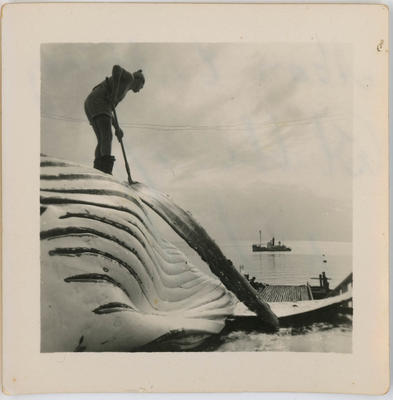Photograph
Production date
1950s
Country
Australia
State/Province
Queensland
See full details
Object detail
Description
A black and white photograph depicting a man removing the blubber from a whale with a long metal instrument.
Classification
PHOTOGRAPHS
PHOTOGRAPHS Maritime
PHOTOGRAPHS Maritime ship
PHOTOGRAPHS Maritime
PHOTOGRAPHS Maritime ship
Maker
Production date
1950s
Production place
Measurements
Length 62mm x Width 62mm
Media/Materials description
Photographic paper
Signature/Marks
Reverse: /MAN CUTTING/ BLUBBER OFF/ WHALE/
History and use
This photograph of a man removing blubber from a whale, a practice known as 'flensing', was taken in the 1950s at Tangalooma whaling station.
Over its ten years of operation, more than six thousand humpback whales and one blue whale were killed and processed at Tangalooma, bring the east coast population of humpback whales to less than five hundred individuals from an original population estimated at fifteen thousand. By 1961, whales were becoming scarce and light planes were employed to spot the whales from the air. In August 1962, only 68 whales had been caught and the whaling station closed.
These historical images were taken by well-known Queensland marine biologist and acknowledged fishing expert Ern Grant. Working as a marine biologist in the early 1960s, Ern Grant collaborated with the Commonwealth Scientific and Industrial Research Organisation (CSIRO) to observe and supervise the collection of data from Tangalooma whaling station.
After a dramatic global decline in whale numbers, humpback and blue whales became protected species in 1965. Sperm whales continued to be hunted until 1978 when commercial whaling in Australia ceased with the closure of Australia's last whaling station, the Cheynes Beach Whaling Company, in Western Australia.
Over its ten years of operation, more than six thousand humpback whales and one blue whale were killed and processed at Tangalooma, bring the east coast population of humpback whales to less than five hundred individuals from an original population estimated at fifteen thousand. By 1961, whales were becoming scarce and light planes were employed to spot the whales from the air. In August 1962, only 68 whales had been caught and the whaling station closed.
These historical images were taken by well-known Queensland marine biologist and acknowledged fishing expert Ern Grant. Working as a marine biologist in the early 1960s, Ern Grant collaborated with the Commonwealth Scientific and Industrial Research Organisation (CSIRO) to observe and supervise the collection of data from Tangalooma whaling station.
After a dramatic global decline in whale numbers, humpback and blue whales became protected species in 1965. Sperm whales continued to be hunted until 1978 when commercial whaling in Australia ceased with the closure of Australia's last whaling station, the Cheynes Beach Whaling Company, in Western Australia.
Associated person
Registration number
H50040



